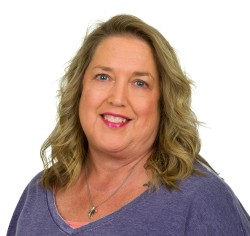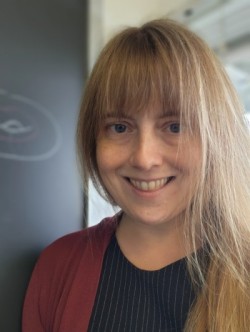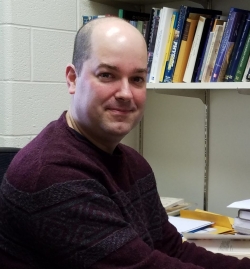Our Fall 2023 meeting was held November 11, 2023 at Villanova University.
The meeting is jointly sponsored with the New Jersey section.
Schedule
View this meeting's schedule
| 8:30 - 10:30 | Registration
Driscoll Lobby |
| 8:30 - 9:00 | Light Breakfast Reception (coffee, tea, pastries)
Driscoll Lobby |
| 9:00 - 9:10 | Welcoming Remarks
Kevin Minbiole, Associate Dean of Research, Villanova
Driscoll 134 |
| 9:15 - 10:05 | Invited speaker: Judith Covington
Math Teachers' Circles - What, Why, When, and How?
Driscoll 134 |
| 10:05 - 10:30 | Coffee Break & Silent Auction
Driscoll Lobby |
| 10:35 - 11:25 | Invited speaker: Kristen Hendricks
A First Look at Knots and Symmetries
Driscoll 134 |
| 11:25 - 11:45 | Business Meeting, Awards, Group Photo
Driscoll 134 |
| 11:45 - 1:00 | Lunch & Table Discussions
Dougherty Hall |
| 1:10 - 2:10 | Faculty/Graduate Speaker Sessions
Driscoll 2nd Floor
Student Activity
Driscoll 134
Faculty Workshop
Driscoll 132 |
| 2:20 - 3:20 | Student Speaker Sessions
Driscoll 2nd Floor |
| 3:20 - 3:40 | Coffee Break & Silent Auction
Driscoll Lobby |
| 3:40 - 4:30 | Invited speaker: Jason Rosenhouse
Dirichlet's Theorem and the Rise of Analytic Number Theory
Driscoll 134 |
| 4:30 - 5:00 | Reception & Silent Auction Winners
Driscoll Lobby |
Invited Speakers
 Judith Covington
Judith Covington
Northwestern State University
Math Teachers' Circles - What, Why, When, and How?
I believe that K-12 teachers are the key to our future. I also believe that in general society does not do enough to support and encourage these teachers. I have spent my career teaching mathematics to future teachers. However, as we all know, learning does not stop at graduation. In 2009 I learned about Math Teachers’ Circles and immediately knew this was something that I needed to provide for my local teachers. In 2010 I created the North Louisiana Math Teachers’ Circle. I will talk about what Math Teachers Circles are and why I so desperately wanted to create one. I will talk about the struggles and the successes of this endeavor and will share tips on how to start your own Math Teachers Circle. And of course, there will be some math problems to solve as well!
Judith Covington received a Bachelor of Science Degree in Mathematics Education from Northwestern State University in Natchitoches, Louisiana, her hometown. She then received a master’s degree and PhD from the University of Southwestern Louisiana, now known as University of Louisiana Lafayette. While a graduate student Judith first became involved in educating future teachers. She spent 25 years at Louisiana State University in Shreveport where she taught courses for future teachers. In 2010, Judith founded the North Louisiana Math Teachers’ Circle and for 8 years ran a very successful circle until she returned to teach at Northwestern State in 2018. Judith has an extensive background working with the MAA. She is an original (1994) Project NExT Red dot and served on the Project NExT leadership team from 1997 until 2014. She has also served as a MAA Governor-at- Large for teacher education as well as the Governor/Representative of the Louisiana Mississippi Section where she is currently serving as the section chair.
View bio
 Kristen Hendricks
Kristen Hendricks
Rutgers University
A First Look at Knots and Symmetries
A mathematical knot is a simple object -- take a piece of string, tie it up however you like, and glue the ends together so you can't untie it. But these deceptively easy objects to describe and fiddle with are key to understanding deep geometric questions, many not nearly so accessible. We'll introduce knots and consider some possible measures of how complicated a knot is, before turning our attention to one of my favorite topics, possible symmetries of knots. In the end, we'll see how different types of symmetry have wildly different relationships with how "complicated" the knots involved are.
Kristen Hendricks is a low-dimensional and symplectic topologist. Most of her work is focused on developing equivariant versions of various Floer-theoretic invariants and exploring their applications to problems of 3-manifolds and knots. She did her undergraduate degree in mathematics at Harvard, followed by doctoral work at Columbia and a postdoctoral position at UCLA. After three years as an assistant professor at Michigan State, she moved to Rutgers, where she is presently an associate professor. Her work has been recognized by an NSF CAREER grant (2018), a Sloan Research Fellowship (2019), and an AWM Birman Research Prize in Topology and Geometry (2023). When not doing mathematics, she enjoys science fiction novels and unnecessarily complicated knitting projects.
View bio
 Jason Rosenhouse
Jason Rosenhouse
US Air Force Academy
James Madison University
Dirichlet's Theorem and the Rise of Analytic Number Theory
In 1837, Peter G. L. Dirichlet proved the following theorem: If a and d are relatively prime integers, then the arithmetic progression a, a+d, a+2d, ... contains infinitely many prime numbers. His proof ushered in a revolution in number theory because it relied in a critical way on complex analysis. The use of analytic methods to solve problems in number theory was a tremendous innovation at the time. We shall consider some of the details of Dirichlet's proof, focusing on understanding why there is a deep connection between these seemingly unrelated branches of mathematics.
Jason Rosenhouse is a professor of mathematics at James Madison University, Harrisonburg, VA. For the 2023-2024 academic year, he is the Distinguished Visiting Professor in the Department of Mathematical Sciences at the U. S. Air Force Academy, Colorado Springs, CO. He received his PhD in mathematics from Dartmouth College, Hanover, NH in 2000, specializing in number theory and combinatorics. He is the author or editor of nine books on topics such as recreational mathematics and evolution vs. creationism. Currently, he is the editor of Mathematics Magazine, published by the MAA. When not doing math, he enjoys chess, cooking, and reading locked-room mysteries.
View bio
Student Activity

Faculty Workshop
Led by Judith Covington and hosted by Section NExT.
This workshop will be run as a modified Math Teachers’ Circle session. Participants will be divided into groups of three to four to participate in an activity that has been used in a Math Teachers’ Circle session. Additional topics may be shared as time allows. Questions are encouraged and the session may be changed to fit the requests of those attending.
Lunch Table Discussions
Lunch tables will feature optional discussion topics for attendees. Click here (PDF) for a list of topics.
Local Organizers
The local organizers for this meeting are
Alexander Diaz-Lopez,
Katie Haymaker, and
Bob Styer
of Villanova. Please contact a local organizer with site-specific questions, or contact an Executive Committee member with more general questions.



